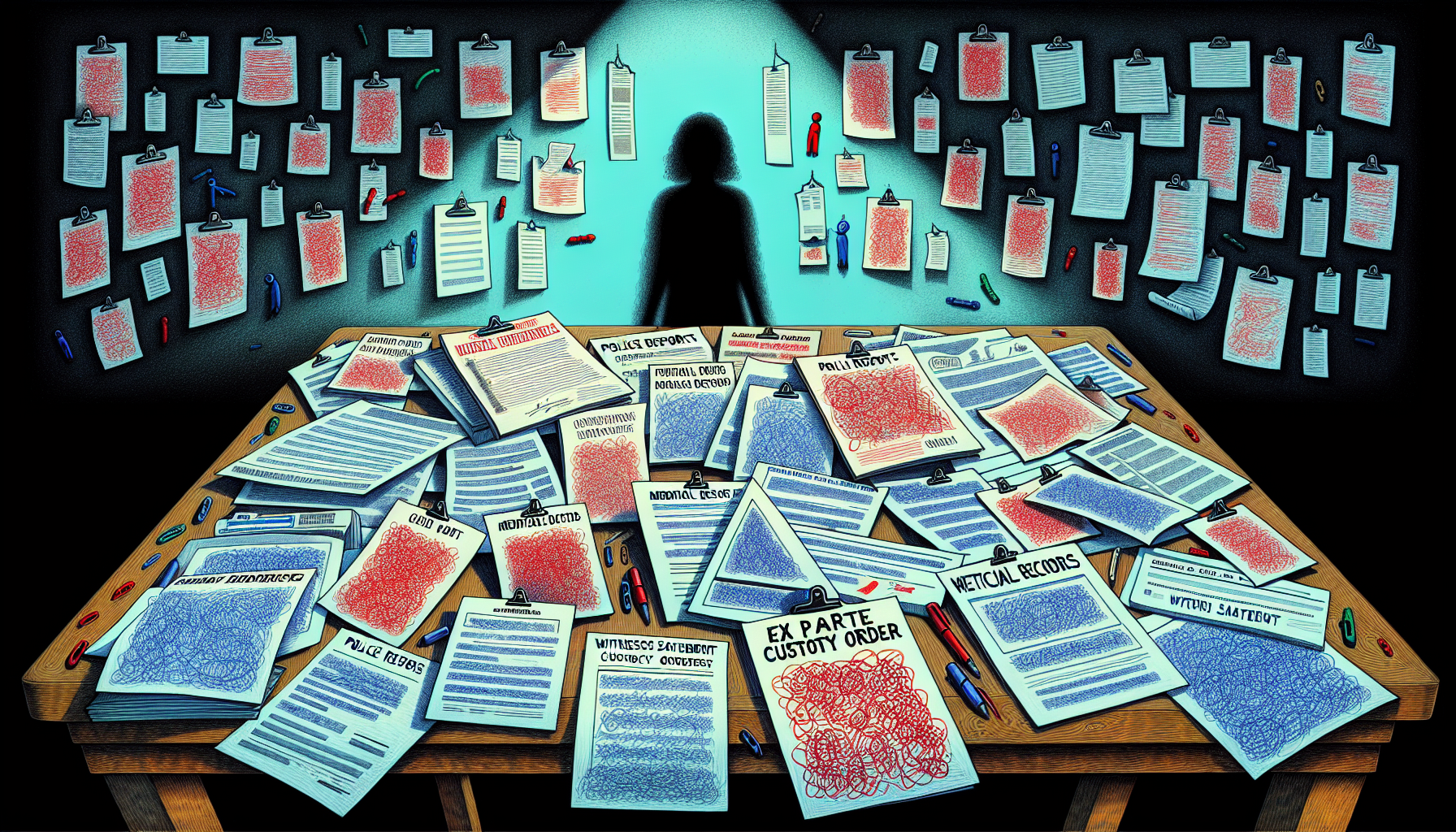An ex parte custody order is a legal tool to protect children in immediate danger. It allows one parent to get temporary custody without notifying the other parent first. This guide explains what an ex parte custody order is, when you need one, and how to file for it.
Key Takeaways
Ex parte custody orders are emergency legal measures used to protect a child from immediate danger, such as domestic violence, child abuse, or abduction, and are only granted under dire circumstances.
Filing for an ex parte custody order requires submitting detailed, compelling evidence that proves imminent harm to the child. Proper legal guidance from a family law attorney is highly recommended.
Ex parte custody orders are temporary solutions that maintain the child’s safety until a follow-up hearing can be conducted. This subsequent hearing allows for a thorough review and more comprehensive deliberation.
Understanding Ex Parte Custody Orders
The term ‘ex parte’ might sound like legal jargon plucked from a courtroom drama, but it’s a lifeline in the real world when a child’s safety hangs in the balance. Ex parte custody orders are akin to an S.O.S. signal in family law; they call for immediate legal action without the presence of the opposing party. Imagine a scenario where time is of the essence, and the usual legal to-and-fro could mean the difference between safety and peril for a child. That’s where an ex parte custody application steps in, offering a temporary haven in the storm.
These orders are not given out like candy on Halloween; they’re reserved for dire emergencies—think domestic violence, child abuse, or a sudden, unconsented move across borders. The judicial system maintains a tight grip on the issuance of ex parte orders, ensuring they’re only used when absolutely necessary to prevent immediate danger or irreparable harm. After all, invoking such a powerful tool without just cause would not only strain court resources but also unjustly tip the scales of justice. In this context, the enforcement act plays a crucial role in regulating the use of ex parte orders.
What then, you may wonder, does it take for a judge to grant this urgent plea? The answer lies in the balance of credible allegations and the immediate risk they pose. A judge will only drop the gavel on an ex parte order if convinced that it’s the only way to shield a child from imminent harm. It’s a legal Hail Mary that, when justified, echoes the court’s protective echo for a child’s welfare.
Situations Warranting an Ex Parte Custody Order

Delving deeper into the world of ex parte orders, one might question what qualifies as an ‘emergency’ in the eyes of the court. The threshold is high; the situation must scream immediate danger or pose an irrevocable threat to a child’s safety. This isn’t about a scraped knee or a missed curfew. We’re talking about the kind of harm that leaves lasting scars, be it physical, emotional, or both.
The court’s ear perks up to the mention of domestic violence, sexual abuse, or the specter of child abduction. When a parent plots a covert operation to whisk a child away to foreign lands without consent, or when the home becomes a battleground rather than a safe haven, the ex parte alarm sounds. These are not just red flags; they’re blazing infernos signaling children involved in the crosshairs of harm.
It’s not only about the harm that’s been done but also the harm that’s brewing. A parent’s mental instability, substance abuse, or refusal to allow the other parent’s visitation rights can all trigger the need for an ex parte order. It’s a protective barrier erected in the nick of time, a recognition that when it comes to a child’s well-being, there’s no room for delay.
Filing for an Ex Parte Custody Order
So, you’ve identified the emergency and need to act fast—what’s next? Filing for an ex parte custody order is like launching a rescue mission: precise, swift, and by the book. If you don’t have an existing family law case, it’s time to start one because this order doesn’t stand alone; it works within the framework of broader legal proceedings.
As you prepare your case, think of the paperwork as your arsenal. You’ll need to submit a set of forms specific to requesting a temporary emergency order, and these documents must lay bare the nature of the emergency with unflinching detail. Remember, you’re asking a judge to make a pivotal decision on limited notice, so your application must be clear, compelling, and capped at 10 pages to avoid overwhelming the court.
At this stage, the guidance of a family law attorney becomes invaluable. They’re the strategists in your corner, helping you navigate the procedural maze and ensuring your application hits the mark with pinpoint accuracy. They’ll assist with drafting affidavits, compiling evidence, and adhering to local court protocols—all vital steps to ensure your voice is heard when time is against you.
Notice Requirements for Ex Parte Custody Hearings

You’ve filed the paperwork, but before the court can weigh your request, there’s another critical step: notice. The law demands fairness, even in urgency, which means the other parent must be informed of the impending hearing at least one day in advance. It’s a courtesy call with heavy implications, one that lays out the what, when, and where of the application you’ve set in motion.
This notice isn’t just a formality; it’s a safeguard against unilateral decision-making. It allows the other parent a brief window to prepare, to gather their thoughts and perhaps their defense. The rules are clear: serve the papers, communicate the details, and then the court shall proceed. It’s a balancing act between speed and due process, ensuring that while one parent seeks shield, the other isn’t left in the dark.
Evidence Needed for an Ex Parte Custody Order

With the notice given, the spotlight turns to evidence. In the courtroom, your word alone won’t suffice; you need concrete proof to back up your claims of immediate harm or risk to the child. This could take the form of police reports, medical records, or witness statements—each piece contributing to a mosaic of urgency that the judge must see clearly.
The stakes are high, and so is the bar for evidence. A lack of solid proof is the most common reason why ex parte requests fall flat. You’re asking the court to make a snap decision; the evidence must not only be compelling but also fresh, pertinent, and convincing enough to warrant an immediate response.
Here again, a family law attorney can be your ally in child custody cases, helping to assemble the necessary documentation and present it in a way that resonates with the gravity of the situation. It’s about painting a picture so vivid that the judge has no choice but to act, and act swiftly, to protect the child involved and ensure appropriate child support.
What Happens During an Ex Parte Hearing
On the day of the hearing, the court becomes the arena where your preparedness is put to the test. Judges have the discretion to rule based on the paperwork alone or to hear oral arguments before deciding. However, in family law, the judge often relies solely on the submitted documents, making every word you’ve written all the more critical.
The outcome of this hearing, be it an order granted or denied, will be documented formally, often on a pre-determined form. This document becomes the temporary rule of law until the court has a chance to hear both sides in full. The judge may fully grant your request, deny it, or perhaps only agree to certain parts of it, demonstrating the nuanced approach taken in such sensitive cases.
If the judge opts not to grant emergency relief, don’t lose heart. A regular hearing may be scheduled, or the court may expedite proceedings to address the matter faster. In cases involving uniform child custody jurisdiction, especially those with allegations of child abuse, the judge might order supervised visitation or mandate parenting classes to ensure the child’s safety while the process unfolds.
Temporary Nature of Ex Parte Orders
It’s important to remember that ex parte custody orders are not a final verdict but a stopgap measure, a temporary shield until the court can deliberate more thoroughly. In California, these orders typically last until the hearing date, which is usually set within 21 days of the emergency hearing.
During this temporary phase, the order remains in force, maintaining the status quo and ensuring the child’s safety until the judge can review all the evidence at the follow-up hearing. This subsequent hearing is where the temporary order’s fate is decided: it may be extended, modified, or dissolved, depending on the findings of a more comprehensive review.
The judge’s role as a guardian of justice is never more evident than in these moments, where the temporary nature of ex parte orders ensures that decisions made in haste are revisited with the full weight of evidence and argument from both sides.
Opposing an Ex Parte Custody Request
But what if you’re on the other side of the equation, receiving notice of an ex parte custody request filed against you? Your first move is to get your hands on all related paperwork, scrutinize the parte custody application, and prepare your counter-arguments. This is when having a seasoned family law attorney becomes a strategic advantage, providing the expertise to craft a robust opposition.
Armed with evidence and legal counsel, you’ll walk into the final hearing with the opportunity to present your side of the story, to challenge the allegations, and to influence the judge’s final decision. It’s a chance to ensure that your voice is heard and that the temporary order doesn’t become a permanent fixture without fair consideration.
Post-Hearing Procedures and Follow-Up
After the dust settles on the ex parte hearing, the legal journey continues. The judge’s decision, typically delivered swiftly after the hearing, sets the stage for what comes next. If the temporary emergency order is granted, a follow-up hearing is scheduled to dive deeper into the case and explore the need for the order’s extension or modification.
Should the ex parte order be denied, the petitioner isn’t necessarily at a dead end. There’s room to regroup, to bolster one’s case with additional evidence, or to address the judge’s concerns in a revised filing.
During the full hearing, both parties can:
Lay all their cards on the table
Present all relevant evidence
Provide testimony
Make arguments
This allows the judge to make a well-informed decision.
This subsequent phase often includes a referral to child custody mediation, a step encouraged by the California Family Code to facilitate a resolution outside the courtroom. If mediation proves successful, the parties will return to court for a subsequent hearing, armed with a mediation report and ready to present a united front or, if necessary, continue their legal battle.
The Role of a Family Law Attorney
Throughout the turbulent seas of ex parte custody orders, a family law attorney is the lighthouse guiding you to safe harbor. Their role is critical, whether you’re filing for an order or opposing one, ensuring that your legal strategy is sound and your rights are protected.
They bring a wealth of knowledge and experience to the table, offering guidance at every turn—from the initial application to the opposition and beyond. Their expertise not only strengthens your case but can also provide a sense of clarity and calm in what is often a stormy and emotional process.
Summary
In the labyrinthine world of family law, ex parte custody orders stand out as a rapid response to crises where a child’s immediate safety is at stake. From understanding their urgent nature to navigating the complex proceedings, the journey is fraught with legal intricacies. It’s a path best traversed with a seasoned family law attorney by your side, ensuring the child’s welfare remains paramount and that justice is served with both speed and fairness.
Frequently Asked Questions
What exactly is an ex parte custody order?
An ex parte custody order is a temporary court order granted without the opposing party’s presence, usually in emergency situations where a child’s safety is at immediate risk.
When can an ex parte custody order be issued?
An ex parte custody order can be issued in situations involving domestic violence, child abuse, or the risk of a child being taken out of state or country without consent. Be aware of these circumstances if you are seeking an ex parte custody order.
What evidence do I need for an ex parte custody order?
To obtain an ex parte custody order, you will need compelling evidence such as police reports, medical records, witness statements, or any other proof of immediate harm or risk to the child. This evidence is crucial for demonstrating the need for urgent intervention in the child’s best interest.
How long does an ex parte custody order last?
An ex parte custody order typically lasts until the follow-up hearing, which generally takes place within 21 days. These orders are temporary in nature.
Can I oppose an ex parte custody order against me?
Yes, you can oppose an ex parte custody order by obtaining relevant paperwork, hiring a family law attorney, and presenting your case at the final hearing. Consider seeking legal assistance to navigate the process effectively.


